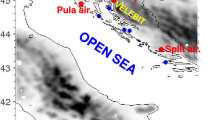Abstract
A mesoscale boundary-layer model (BLM) is used for running 12-h low-level wind forecasts for the La Plata River region. Several experiments are performed with different boundary conditions that include operational forecasts of the Eta/CPTEC model, local observations, as well as a combination of both. The BLM wind forecasts are compared to the surface wind observations of five weather stations during the period November 2003–April 2004. Two accuracy measures are used: the hit rate or percentage of cases with agreement in the wind direction sector, and the root-mean-squared error (RMSE) of the horizontal wind components. The BLM surface wind forecasts are always more accurate, since its averaged hit rate is three times greater and its averaged RMSE is one half smaller than the Eta forecasts. Despite the large errors in the surface winds displayed by the Eta forecasts, its 850 hPa winds and surface temperature forecasts are able to drive the BLM model to obtain surface winds forecasts with smaller errors than the Eta model. An additional experiment demonstrates that the advantage of using the BLM model for forecasting low-level winds over the La Plata River region is the result of a more appropriate definition of the land–river surface temperature contrast. The particular formulation that the BLM model has for the geometry of the river coasts is fundamental for resolving the smaller scale details of the low-level local circulation. The main conclusion of the study is that operational low-level wind forecasts for the La Plata River region can be improved by running the BLM model forced by the Eta operational forecasts.
Similar content being viewed by others
References
Berri GJ, Nuñez MN (1993) Transformed shoreline-following horizontal coordinates in a mesoescale model: a sea–land breeze case study. J Appl Meteorol 5: 918–928
Black TL (1994) The new NMC mesoscale Eta model: description and forecast examples. Weather Forecast 9: 265–278
Bustamante J, Gomes JL, Chou SC, Rozante JR (1999) Evaluation of April 1999 rainfall forecasts over South America using the Eta Model. Climanálise, No. 5, Cachoeira Paulista, SP, Brazil
Case JL, Manobianco J, Lane JE, Immer CD, Merceret FJ (2004) An objective technique for verifying sea breezes in high-resolution numerical weather prediction models. Weather Forecast 19: 690–705
Colby FP Jr (2004) Simulation of the New England sea breeze: the effect of grid spacing. Weather Forecast 19: 277–285
Cormier DR, Marsh L (2001) Spline regression models. Sage Publications, Thousand Oaks, p 80
Cressman GP (1959) An operative objective analysis scheme. Mon Wea Rev 87: 367–374
Daggupaty SM (2001) A case study of the simultaneous development of multiple lake-breeze fronts with a boundary layer forecast model. J Appl Meteorol 40: 289–311
Hanna SR, Yang R (2001) Evaluations of mesoscale models’ simulations of near-surface winds, temperature gradients, and mixing depths. J Appl Meteorol 40: 1095–1104
Mesinger F, Black TL (1992) On the impact on forecast accuracy of the step-mountain (eta) vs. sigma coordinate. Meteorol Atmos Phys 50: 47–60
Pielke RA (1974) A three dimensional numerical model of the sea breezes over the South Florida. Mon Wea Rev 102: 115–139
Pielke RA, Cotton WR, Walko RL, Tremback CJ, Lyons WA, Grasso LD, Nicholls ME, Moran MD, Wesley DA, Lee TJ, Copeland JH (1992) A comprehensive meteorological modeling system RAMS. Meteorol Atmos Phys 49: 69–91
Roebber PJ, Gehring MG (2000) Real-time prediction of the lake breeze on the western shore of Lake Michigan. Weather Forecast 15: 298–312
Seluchi ME, Chou SC (2001) Evaluation of two Eta model versions over South America. Rev Geofis 40: 219–238
White BG, Paegle J, Steenburgh JW, Horel JD, Swanson RT, Cook LK, Onton DJ, Miles JG (1999) Short-term forecast validation of six models. Weather Forecast 14: 84–108
Wilks DS (1995) Statistical methods in the atmospheric sciences. Academic Press, New York, 240 pp
Zhang Y, Chen Y, Schroeder TH, Kodama K (2005) Numerical simulations of sea-breeze circulations over northwest Hawaii. Weather Forecast 20: 827–846
Zhong S, Fast J (2003) An evaluation of the MM5, RAMS, and Meso-Eta models at subkilometer resolution using VTMX field campaign data in the Salt Lake Valley. Mon Wea Rev 131: 1301–1322
Author information
Authors and Affiliations
Corresponding author
Additional information
L. Sraibman and G. J. Berri—Members of Consejo Nacional de Investigaciones Científicas y Técnicas (CONICET) of Argentina.
An erratum to this article can be found at http://dx.doi.org/10.1007/s10546-009-9358-6
Rights and permissions
About this article
Cite this article
Sraibman, L., Berri, G.J. Low-Level Wind Forecast over the La Plata River Region with a Mesoscale Boundary-Layer Model Forced by Regional Operational Forecasts. Boundary-Layer Meteorol 130, 407–422 (2009). https://doi.org/10.1007/s10546-009-9350-1
Received:
Accepted:
Published:
Issue Date:
DOI: https://doi.org/10.1007/s10546-009-9350-1




